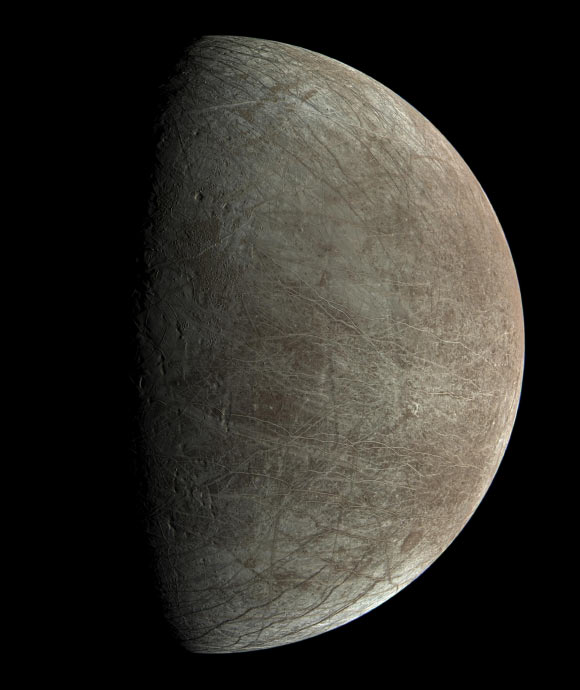The subsurface ocean of Jupiter’s icy moon Europa is heated from below via tidal heating and radioactive decay of the rocky interior, while being cooled from above by its frozen surface. Simulations and lab experiments suggest that this results in convection, whereby heat is transported in rising and sinking plumes of warm and cold water. These plumes are influenced by Europa’s rotation and consequently form jets of alternating east-west oceanic currents. At the surface, the flowing ocean exerts friction on the ice, causing it to move. In new research, planetary scientists from NASA’s Jet Propulsion Laboratory, the University of Oxford and Hokkaido University simulated this process using a large-scale computer model of Europa’s ocean. Their simulations show that the jets can exert enough friction on the ice to be relevant in understanding how the ice shell rotates.
Hay et al. suggest that ocean currents may contribute to any nonsynchronous rotation of Europa’s ice shell; consequently, Europa’s present-day spin state may hold information about the dynamics of its subsurface ocean. Image credit: NASA / JPL-Caltech / SwRI / MSSS / Björn Jónsson / CC BY-NC-SA 2.0.
For decades, planetary scientists have debated whether Europa’s icy shell might be rotating faster than the deep interior.
But rather than tying it to the ocean’s movement, they focused on an outside force: Jupiter.
They theorized that as the gas giant’s gravity pulls on Europa, it also tugs on the moon’s shell and causes it to spin slightly faster.
“It was known through laboratory experiments and modeling that heating and cooling of Europa’s ocean may drive currents,” said Dr. Hamish Hay, a researcher at the University of Oxford.
“Now our results highlight a coupling between the ocean and the rotation of the icy shell that was never previously considered.”
“It might even be possible, using measurements gathered by NASA’s upcoming Europa Clipper mission, to determine with precision how fast the icy shell rotates.”
“When scientists compare images gathered by Europa Clipper with those captured in the past by NASA’s Galileo and Voyager missions, they will be able to examine locations of ice surface features and potentially determine if the position of the moon’s icy shell has changed over time.”
Using techniques developed to study Earth’s ocean, Dr. Hay and colleagues relied on NASA supercomputers to make large-scale models of Europa’s ocean.
They explored the complexities of how the water circulates, and how heating and cooling affects that movement.
In the simulations, the circulation initially moved vertically, but the rotation of the moon as a whole caused the flowing water to veer in a more horizontal direction — in east-west and west-east currents.
The researchers, by including drag in their simulations, were able to determine that if the currents are fast enough, there could be adequate drag on the ice above to speed up or slow down the shell’s rotation speed.
The amount of interior heating — and thus, circulation patterns in the ocean — may change over time, potentially speeding up or slowing rotation of the icy shell above.
“To me, it was completely unexpected that what happens in the ocean’s circulation could be enough to affect the icy shell. That was a huge surprise,” said Europa Clipper project scientist Dr. Robert Pappalardo, a researcher at NASA’s Jet Propulsion Laboratory.
“And the idea that the cracks and ridges we see on Europa’s surface could be tied to the circulation of the ocean below — geologists don’t usually think, ‘Maybe it’s the ocean doing that’.”
“The work could be important in understanding how other ocean worlds’ rotation speeds may have changed over time,” Dr. Hay said.
“And now that we know about the potential coupling of interior oceans with the surfaces of these bodies, we may learn more about their geological histories as well as Europa’s.”
The findings will be published in the Journal of Geophysical Research: Planets.
_____
H.C.F.C. Hay et al. 2023. Turbulent Drag at the Ice-Ocean Interface of Europa in Simulations of Rotating Convection: Implications for Nonsynchronous Rotation of the Ice Shell. JGR: Planets 128 (3): e2022JE007648; doi: 10.1029/2022JE007648




